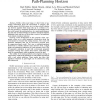102 search results - page 18 / 21 » A framework for early robustness assessment |
CVPR
2006
IEEE
14 years 8 months ago
2006
IEEE
We propose a novel, fast and robust technique for the computation of anatomical connectivity in the brain. Our approach exploits the information provided by Diffusion Tensor Magne...
IROS
2006
IEEE
14 years 21 days ago
2006
IEEE
Abstract— Mobile robots need maps or other forms of geometric information about the environment to navigate. The mobility sensors (LADAR, stereo, etc.) on these robotic vehicles ...
ISBRA
2007
Springer
14 years 25 days ago
2007
Springer
The fundamental goal of computational neuroscience is to discover anatomical features that reflect the functional organization of the brain. Investigations of the physical connect...
BMCBI
2006
13 years 6 months ago
2006
Background: The incorporation of statistical models that account for experimental variability provides a necessary framework for the interpretation of microarray data. A robust ex...
BMCBI
2006
13 years 6 months ago
2006
Background: Prediction of human cell response to anti-cancer drugs (compounds) from microarray data is a challenging problem, due to the noise properties of microarrays as well as...

